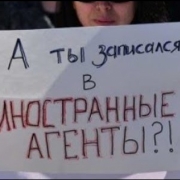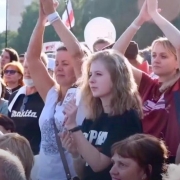EN | You Cannot Fight Digital Technology with Rubber Bullets: The Surprising Rise of the Pro-Democracy Movement in Belarus
[ANALYSIS Bulletin No. 6] Sven Gerst | In the early phases of the Internet, tech optimists predicted that the widespread availability of new communication platforms will eventually lead to a new wave of democratization and civic empowerment. However, recent developments have not only challenged this storyline; but shown reverse effects. Authoritarian regimes—most notably China and Russia—have used digital technology to extend their social and political reach and bolster surveillance, the persecution of citizens, and the spread of propaganda and disinformation.
And it could even be argued that it was precisely those digital technologies that allowed such regimes to turn declining democracies into the full-fleshed autocracies that they are now.[1] However, these observations should also not tempt us to turn into tech pessimists. Because there is Belarus—where decentralized messaging apps gave rise to a democratic revolution in the most unlikely of all places.
Of course, by now so-called Twitter Revolutions are nothing new. We have seen them all around the world—from Moldova to Taiwan to the Middle East. But there are some particularities that make Belarus a curious case study. Because one of the best explanations for this sudden (and certainly unexpected) formation of a large-scale pro-democracy movement can be found in the analysis of the intersection between political organization and technology.
Traditional Forms of Resistance under Authoritarianism
Unlike in liberal democracies, opposition and dissident movements in authoritarian political contexts traditionally organize themselves under the banner of a leader figure. In order words, strongman leaders usually get challenged by other strong, charismatic leaders. This has various reasons. Most notably the fact that dictatorships tend to not only to consolidate power in favor of a specific position but also create a so-called Cult of Personality.[2]
In such highly personalized political environments, opposition movements are coordinated via hierarchical structures—where the leader figure is operating as the focal point of uniting collective political efforts. While such centralized structures allow for streamlined communication as well as effective and efficient coordination, they also suffer from their inherent reliance on individual leaders.
Therefore, it is unsurprising that authoritarian regimes have often countered such movements by attacking their central coordination points through preemptive repression and/or isolation of their leaders. In fact, such dynamics have dominated the political landscape in Belarus ever since its independence in 1994. Whenever potential challengers to Lukashenko were about to rise and gain traction, the regime channeled its efforts to remove those public leaders and most often forced them into exile.
The Emergence of Networked Protests
While hierarchical movements remain the dominant form of political coordination in authoritarian societies, the advent of digital communication technology—such as social media platforms or direct messaging apps—gave rise to new forms of social coordination: Networked Protest.[3]
For example, the Euromaidan protests in Ukraine that sparked in 2013 were able to induce political change without traditional elements of centralized leadership. Instead, the movement heavily relied on the decentralized efforts of a widespread network of political, civic, and cultural groups loosely connected via digital communication platforms.[4]
While such non-hierarchical forms of social coordination often suffer from mixed messaging and a lack of formal representation, the Euromaidan movement was able to achieve what traditional hierarchical structures were unable to accomplish. However, such success stories should not get us too hopeful. Similar protests in Turkey (i.e. Gezi Park Protests) and the Middle East (i.e. Arab Spring) were unable to deliver lasting change despite their ability to mass mobilize via Twitter and Facebook.
The Powers & Weaknesses of Networked Protests
Obviously, there is much more to say about networked protests.[5] However, this short glimpse into the very nature of political action should have revealed that organizational structures play a crucial role in a movement’s ability to realize its goals. While hierarchical opposition movements have been able to pose serious threats to strongman leaderships, authoritarian regimes have adapted to those challenges and developed expertise, strategies, and capacities to counter such dissident movements effectively.
Networked Protests that are organized via multiple nods of coordination and connected via digital communication technology do not suffer from such vulnerabilities. Due to their decentralized structures, they tend to be much more robust and less prone to be toppled by outside attacks. However, connective movements face other important challenges. While Networked Protests are a very powerful tool of mass mobilization due to the speed and reach of their digital infrastructure, it is this very disruptive potential that often conceal and distract from a lack of internal capacities.
Connective movements tend to overestimate their own capacities and are governed by constant ad hoc adjustments undermining the long-term outlook and prospects. It seems that in the age of social media, the amount of people that one can bring to the streets is not necessarily an indicator of the strength of a campaign anymore. Moreover, Networked Protests lack shared deliberation and decision-making experience and therefore tend to struggle at the first serious roadblocks—such as settling for a common agenda or spokesperson.
The Belarusian Update to Networked Protests: The Hybrid Model
Now back to Belarus. Because what we have observed during the presidential race in Belarus in 2020 combines all these insights. When with Viktar Babaryka a new strong challenger emerged in the presidential bid this year, the Lukashenko regime countered this movement through the usual tactics—and detained Babaryka based on allegation of money laundering. However, the authorities (as well as political commentators) did not take into consideration that in meantime a powerful digital infrastructure has emerged in the country: Due to the infamous mishandling of the COVID-19 pandemic by the government[6], Belarusians have created crowdfunding platforms and Telegram groups that connected regime-critical forces already prior to the presidential race.
In the aftermath of the Babaryka arrest, these digital tools turned political. And the (more or less) accidental bid of Sviatlana Tsikhanouskaya, the wife of an also detained video blogger, was able to weaponize this digital infrastructure.
The biggest telegram channel NEXTA reached almost 2 million subscribers within weeks. What emerged can be best described as a hybrid model of decentralized communication hubs amplifying the message of a strong leader figure. This allowed Tsikhanouskaya to launch an unprecedented opposition campaign basically overnight. In addition, this pro-democracy movement was able to maintain its strength even when Tsikhanouskaya was forced into exile right after the elections due to its decentralized nature. Of course, removing the central figurehead led to internal disputes amongst the radical and moderate fractions of the movement; nevertheless, it was still able to bring hundreds of thousands of protestors to the street each week—to bridge the time before a new leading figure could emerge.
It is still too early to tell the tale, but the hybrid model of the Belarusian protests has shown how effective resistance in an authoritarian context can look like: combining traditional elements of political leadership with a decentralized digital communication infrastructure. And it is to be expected that more such structures will emerge in autocracies all around the world rather soon, as it is much needed.
Sven Gerst is a PhD Student in Political Economy at the Department of Political Economy at King’s College London. He has an interdisciplinary background in economics, political science, and philosophy with degrees from the London School of Economics and Political Science (LSE) and the University of Mannheim. Previously, he also studied and worked at Harvard University, Duke University, St. Petersburg State University, and National Taiwan University. Sven is also the Secretary General of the International Federation of Liberal Youth (IFLRY)—a global umbrella organization for all liberal youth organizations and which represents 1.2m young people. He is based in Minsk.
This material was developed by LID Moldova experts under the project The Best Way: Periodic Bulletin funded by the Friedrich Naumann Foundation for Freedom (FNF). Opinions and conclusions expressed in this material are those of the authors and the experts and do not necessarily reflect the position of the funder.
Elements of text, images, tables, or charts may be taken over provided that the source is cited, i.e. LID Moldova, and that the appropriate hyperlink is attached.
Copyright © LID Moldova
References:
[1] Yuval Noah Harari, Why Technology Favors Tyranny.
[2] Frank Dikötter: How to Be a Dictator: The Cult of Personality in the Twentieth Century.
[3] Zeynep Tufekci: Twitter and Tear Gas.
[4] Tetyana Bohdanova: Unexpected Revolution: The Role of Social Media in Ukraine’s Euromaidan Uprising.
[5] For example: Aliaksandr Herasimenka: Adjusting Democracy Assistance to the Age of Digital Dissidents.
[6] Chatham House: Belarusians Left Facing COVID-19 Alone.
Images sources: media.npr.org, GMF ReThink









 Liviu Iancu Cele mai importante aspecte ale alegerilor pentru cel de-al nouălea Parlament European 1
Liviu Iancu Cele mai importante aspecte ale alegerilor pentru cel de-al nouălea Parlament European 1 

Leave a Reply
Want to join the discussion?Feel free to contribute!